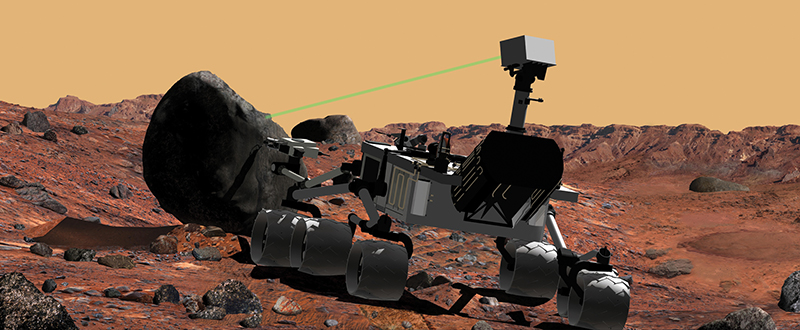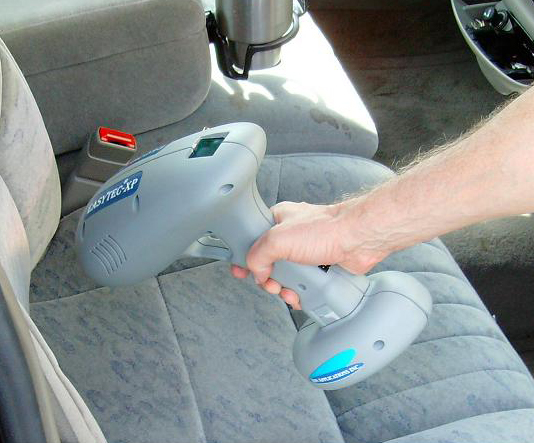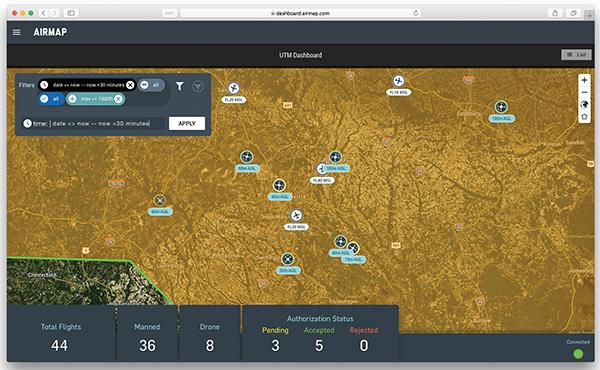
Hand-Held Devices Detect Explosives and Chemical Agents
Originating Technology/NASA Contribution
Smaller, with enhanced capabilities. Less expensive, while providing improved performance. Energy efficient, without sacrificing capabilities. Smaller, less expensive, and energy efficient—but still highly durable under some of the most extreme conditions known.
Contradictions like these are commonplace when designing sensor instruments for spacecraft. The Curiosity Mars Science Laboratory, for example, is set to launch in 2011 with an anticipated 10 instruments onboard that must endure the launch, an 8-month journey to Mars, landing, and the unfriendly environment of the Red Planet. Packing that much scientific punch into a single, reliable, one-shot package requires the most advanced technology available.
Given the high cost of development and launch; the need for consistent, high-level operation in harsh conditions and without the possibility of maintenance; and the limited real estate available on a spacecraft; NASA continually seeks ways both to develop new sensor technology and to advance existing devices to meet the demands of space exploration—in many cases through collaboration with private industry. Sometimes, the effort results in smaller, less expensive, more energy efficient, and highly durable products for use on Earth, as well.
Partnership
NASA’s Astrobiology Science and Technology Instrument Development (ASTID) program encourages the development of innovative instruments equally capable of fulfilling astrobiology science requirements on space missions or related science objectives on Earth. Through ASTID and the Small Business Innovation Research (SBIR) program, Ion Applications Inc., of West Palm Beach, Florida, worked to meet NASA’s need for a miniature version of a powerful sensor technology known as an ion mobility spectrometer (IMS).
Ion mobility spectrometry is a fast, highly sensitive method for separating and identifying gaseous molecules. In an IMS device, ionized molecules sampled from the air travel through a drift tube containing a buffer gas. The speed of travel is influenced by the ion’s mass, size, shape, and charge. By measuring how quickly the ions migrate through the tube, IMS can identify a significant variety of molecules with part-per-billion sensitivity. The instrument displays lesser sensitivity toward other molecules, such as light hydrocarbons and noble gasses, under normal operating conditions.
“An IMS can basically detect almost anything, from heavyweight compounds all the way down to permanent gasses like hydrogen,” says Alex Lowe, Ion Applications’ vice president of sales and marketing. This capability makes IMS an obviously valuable detection instrument; in particular, it has been the technology of choice for explosives and chemical warfare agent detection since the 1960s and is in widespread use for airport security and military applications.
NASA had already developed a gas chromatograph ion mobility spectrometer (GC-IMS) called the mini-Cometary Ice and Dust Experiment (miniCIDEX). The device combines gas chromatography with ion mobility spectrometry to provide highly sensitive gas analysis for astrobiology missions. While the GC device had been successfully miniaturized, the IMS component needed to be smaller and capable of producing accurate readings with a reduced sample size. With SBIR support from Ames Research Center, Ion Applications developed a unique, miniature, Kovar (an alloy) and ceramic IMS cell; simplified electronics; and software for control and spectra acquisition.
The resulting Mini-Cell IMS proved to be a more sensitive, reliable, and rugged tool than existing IMS technology. For NASA, the improved IMS device could be used for future missions to planets, moons, and comets, or as a space-saving tool to monitor air quality on the International Space Station. On Earth, the applications are proving even more varied and beneficial.
Product Outcome
Ion Applications has commercialized the Mini-Cell IMS in the form of its EASYTEC-XP hand-held detector. Housed in a pistol grip casing with a point-and-shoot sampling mechanism, the EASYTEC-XP solves many of the existing engineering problems surrounding IMS devices, including portability.
“The traditional IMS has some inherent field problems that don’t make it user friendly from a continuous operations standpoint,” Lowe says. Unlike typical IMS devices, EASYTEC-XP does not require membranes to keep out moisture and other ambient air interference. Its IMS cell is 10 times smaller and more sensitive, and the detector requires no calibration and has annual maintenance costs that are about 8 times less expensive than the standard. It also requires no swipes or contact to make measurements, making it an ideal tool for field use.
“The traditional IMS products out there that don’t use our platform aren’t well suited for a number of applications, either in terms of size, price, or convenience,” Lowe says. “We can basically plug into those applications right away.”
Currently, the U.S. Army and Navy are using the EASYTEC-XP for detection of explosives and chemical warfare agents. Soldiers can simply carry the tool to a vehicle, for example, to inspect it for trace explosives or other dangerous chemicals. The device is also in use by international law enforcement, and the company has developed a narcotics detector capable of detecting heroin, cocaine, methamphetamine, and THC. EASYTEC-XP’s versatility, durability, and portable format render it useful for transportation security, port container inspection, general air monitoring, and other military and security applications.
EASYTEC-XP has uses beyond public safety, as well. Ion Applications’ technology is employed in China for high-purity process gas analysis for semiconductor manufacturing. The IMS readily detects damaging moisture in the special gasses used during the manufacturing process. Other industrial applications include cleanroom air monitoring and the detection of toxic gasses produced during industrial processes.
Ion Applications is continuing work on a wide range of potential applications for its NASA SBIR-derived technology, Lowe says.
“This is a platform that is allowing us to put together many commercial products that were never before attractive from an IMS standpoint.”
Kovar™ is a trademark of Carpenter Technology Corporation.
EASYTEC®-XP is a registered trademark of Ion Applications Inc.

Requiring no calibration and no swipes or contact to make measurements, Ion Applications Inc.’s ion mobility spectrometer technology can inspect packages and vehicles for trace explosives and other dangerous chemicals. The device is in use by the U.S. military and international law enforcement.

The Mars Science Laboratory, shown in the rendering above, will carry an anticipated 10 scientific instruments, the most for a Mars rover to date. These instruments must be rugged and powerful while still being able to fit within limited space on the rover platform.













